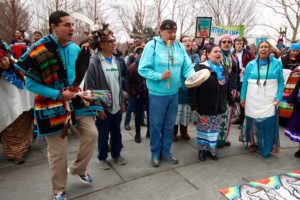Indigenous Women Rise in Washington

By Emilee Gilpin
WASHINGTON, DC—The day after the American President Donald Trump’s inauguration, millions of people across the world took over the streets in protest. In the heart of the capitol of Washington, D.C, a group of Indigenous peoples from many nations formed a circle, danced, sang, drummed, shared medicine, and made sure that the voices of the original peoples were heard amidst all of the noise.
Many organizations, including National Indigenous Women’s Resource Centre, Indigenous Environmental Network, Native Americans in Philanthropy, Ultraviolet, Advance Native Political Leadership, Americans for Indian Opportunity, organized a sub-event to the women’s march called Indigenous Women Rise.
Indigenous Women Rise called people from all nations to join in protest and to ensure that the unique and diverse voices of Indigenous peoples across Turtle Island had a platform to speak and be heard.
A group of women from Akwesasne Mohawk Nation made the 10-hour drive from their community to join in the march.
“It’s important for Haudenosaunee and Onkwehonwe women to stand up and speak up,” said Chelsea Sunday, a member of the group of Mohawk women who attended the events adorned in traditional regalia. “Our people have been involved politically with the United States and Canada since first contact and we can’t stop speaking up and being involved.”
News outlets reported that over 500,000 people marched in Washington alone. The crowd was a massive sea of pink, with many people sporting hats shaped like vaginas, holding signs directed personally to the newly elected President.
The slogans represented a form of talk-back, or perhaps more appropriately ‘scream-back’, towards the racist, sexist, and hate-filled speech President Trump’s platform promoted throughout the campaign.
Amy Sparck is a Cup’ik Alaskan Native who, when asked why she marched, answered proudly that she took the streets for her sons.
“It’s important for them to know that it’s important to value women,” she said. “Not only is it important for Indigenous women to march, but for us to teach our sons that the way you value yourself is the way you value your women.”
Indigenous Women Rise participants met at the National Museum of the American Indian wearing turquoise scarves and shawls, designed by Indigenous artist Bethany Yellowtail.
Organizers of Indigenous Women Rise took turns speaking about support for water protectors in Standing Rock, justice for our Murdered and Missing Indigenous sisters and the rights of Indigenous peoples to protect their land and territories.
Women and men from every direction took turns singing traditional songs and joining together in dance.
Randi Rourke Barreiro is also a member of the Akwesasne Mohawk community.
“We’re not here because we’re against something,” stated Barreiro. “We’re here to celebrate the strength of women. To come out when we’re called and to be those leaders that we want our daughters and future generations to be.”
After singing and drumming for many hours, the group made their way into the packed crowd. Following the voices of organizers like Dallas Goldtooth, Deborah Parker, and Sarah Eagle Heart, participants walked two-by-two singing a Native Women’s Warrior Song from the Pacific Northwest territories.
Like a stream of steady water flowing through beds of many rocks, the group sang, drummed and marched proudly, with signs saying “Indigenous Women Rise,” “Defend the Sacred”, and “Water is Life.”
Onlookers made room, clapped, took photos and commended the group for coming. “Thanks for coming!” was a comment that many non-Indigenous people made. “You looked beautiful!” and “I love your costumes!” were others.
Indigenous participants reflected on the fact that Indigenous peoples have been protesting and defending the land for thousands of years. Did the well-meaning folks who acted amazed by the Indigenous presence remember that the generations of first peoples lived through residential school legacies and continue to push for basic human rights?
Did the participants remember that land and territory has been stolen from Indigenous peoples and that there is no one native? That people came from many nations and represented the spectrum of Indigeneity today?
Whether they remembered and recognized the facts or not, there was no denying the presence and power of the Indigenous peoples marching.
The Indigenous Women Rise group marched all the way to the White House, where they were some of the last participants in the march. The group closed the ceremony with a prayer, embraced one another and then left to prepare for the long journeys home.


